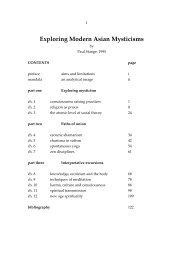Javanese Mystical and Marxist Dialectics - Paul Stange
Javanese Mystical and Marxist Dialectics - Paul Stange
Javanese Mystical and Marxist Dialectics - Paul Stange
You also want an ePaper? Increase the reach of your titles
YUMPU automatically turns print PDFs into web optimized ePapers that Google loves.
late fifties that he reemerged to play a central role. With the new order, there was areturn to the more flexible constitution of 1945 <strong>and</strong> the main doctrines of Sukarno'sthought. The core of the new ideology was the Pantjasila <strong>and</strong> around it anelaboration of images drawn from traditional <strong>Javanese</strong> village structure. ThePantjasila, or “Five Principles”, include nationalism <strong>and</strong> elimination of imperialism,international humanitarianism <strong>and</strong> third world solidarity, a democracy ofmusjawarah-mufakat (deliberation <strong>and</strong> consensus), social justice (sama rasa samarata), <strong>and</strong> belief in one God. The basic ordering principle was that of gotong-rojong -mutual aid <strong>and</strong> cooperation as it was practiced in the more traditional villages. InSukarno's mind the idea of gotong-rojong extended to include the formation of atruly representative cabinet drawing on each of the major political currents ofNasakom (the acronym st<strong>and</strong>ing for nationalism-religion-communism). In thesekeys, Sukarno claimed to have summed up the Indonesian heritage <strong>and</strong> re-geared itfor a modern situation in which the state should take the lead by completing therevolution. 30 For Sukarno the major enemy was always Western liberalism, whetherrepresented by imperialism or liberal rule at home.The main features of the regime have been touched in the introduction - the plethoraof slogans of national unity <strong>and</strong> the series of external confrontations against theDutch <strong>and</strong> Malaysia. Most of the parties of the liberal phase faded into thebackground after the regional strife of the late fifties until the PKI, the military, <strong>and</strong>Sukarno remained. Pragmatic developmental planning gave way to slogans <strong>and</strong>symbols of unity; governmental expenditure concentrated more <strong>and</strong> more on therecreation of Djakarta as a city of monuments, modern buildings, <strong>and</strong> the AsianGames (a third world counter to the Olympics). Military authoritarianism extendedinto the village sphere <strong>and</strong> the political <strong>and</strong> ideological activities of all remainingparties was curtailed.In the villages which had served as a model for ideology, the slogans actually foundsome roots. Gotong-rojong activities remained strongest in areas farthest frommodern penetration but spread somewhat with governmental campaigns to extendvillage cooperatives <strong>and</strong> communal projects. 31 To counter the earlier emergence ofaliran politics <strong>and</strong> tensions, government agencies stressed communal identification<strong>and</strong> tried to encourage the growth of modern coops <strong>and</strong> schools based on traditionalforms <strong>and</strong> resulting from stimulation of voluntary activities. 32 At least to someextent, slogans were interpreted in traditional fashion. In one village meeting of




